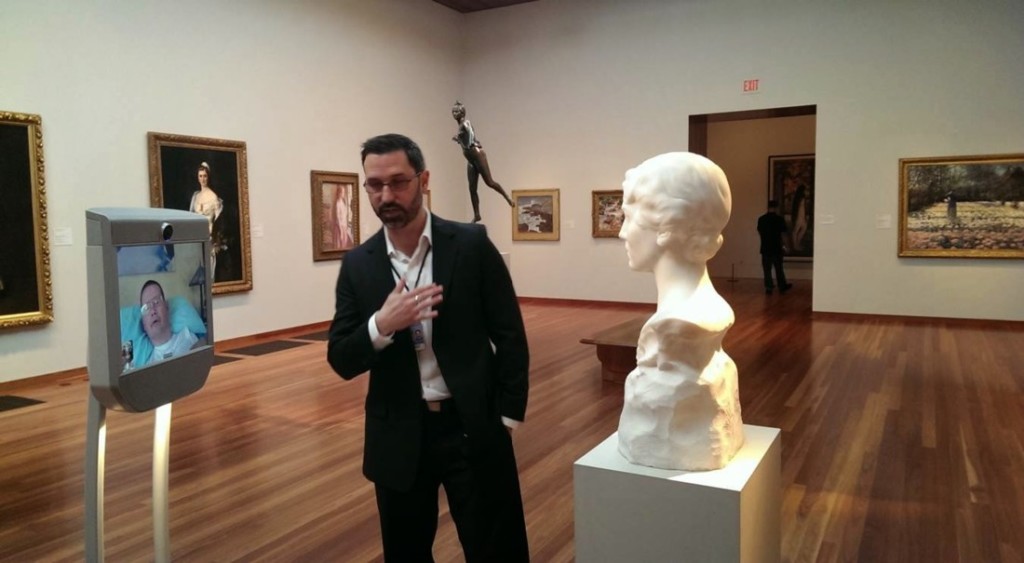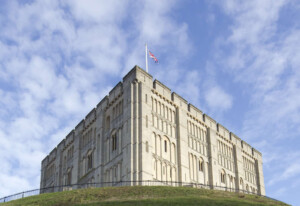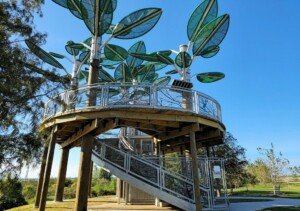What exciting possibilities lie on the museum horizon? Of what should museums by wary? Will robots take over for curators? Will big data offer possibility or privacy-violating peril? How can museums adapt their funding structures to stay competitive and sustainable?
The answers to these questions and more are considered in the Center for the Future of Museum’s annual TrendsWatch report. CFM, an initiative of the American Alliance of Museums (AAM), aims to “help  museums explore the cultural, political and economic challenges facing society and devise strategies to help share a better tomorrow.”
museums explore the cultural, political and economic challenges facing society and devise strategies to help share a better tomorrow.”
By Clara Rice, Jack Rouse Associates.
The report’s author, Elizabeth Merritt (left), is the founder of CFM and has worked with AAM in programs including accreditation and museum assessment since 1999. For the last three years, Merritt has combed CFM’s weekly newsletter, “Dispatches from the Future of Museums”, to determine the seismic shifts in museum technology, organization, fundraising and visitor engagement. The six trends outlined in the 2014 report include social entrepreneurship, multisensory experience, big data, privacy, collaborative consumption and robots.
As Merritt assembles the various articles she uses in her weekly newsletter, she looks for patterns and trends. Specifically, she seeks innovations or ideas that are getting attention from “people in the edgy forefront of their fields” and trends that are getting “deeper analysis from experts and wonks.” Her team then indexes the stories and assigns them specific keywords, and they create a Pinterest board of trend-related images.
Although the trends often relate to cutting-edge technology, the final determination of trends is done in a surprisingly low-tech way: “Finally, in November, I print up all the year’s issues of the newsletter, cut up the stories, paste them on my office wall and start grouping and regrouping them, looking for patterns.” To the extent possible, Merritt and her team strive to present  a balanced approach to the trends, or at least attempt to tell both sides of the coin. Take for example this year’s report, which chronicles the possibilities available from big data but also outlines the privacy risks inherent in such research technologies.
a balanced approach to the trends, or at least attempt to tell both sides of the coin. Take for example this year’s report, which chronicles the possibilities available from big data but also outlines the privacy risks inherent in such research technologies.
Because TrendsWatch is now in its third year, Merritt has been able to observe museums to see if they have adopted any of the trends from the report. Merritt is quick to avoid taking credit for any of these adopted trends and points out that since the report is essentially a culmination of previously published work, many museum professionals have already caught wind of these new innovations or ways of thinking. Merritt herself makes a point of not writing about a trend until she’s read about it having been used 2-3 times in a museum context. She does, however, often receive calls or emails from museums intrigued about a particular trend and requesting more .jpg) information: “I’ll get calls from directors saying ‘…I saw this in TrendsWatch, let tell me more about that’…maybe CFM’s writings helped spark that idea, directly or indirectly. I certainly hope my enthusiastic response reinforced their confidence about their plans.”
information: “I’ll get calls from directors saying ‘…I saw this in TrendsWatch, let tell me more about that’…maybe CFM’s writings helped spark that idea, directly or indirectly. I certainly hope my enthusiastic response reinforced their confidence about their plans.”
Although the trends have varied slightly from year to year, overarching patterns have emerged since the economic downturn of 2008. According to Merritt, the most profound of these patterns has been a “fundamental disruption in the traditional museum income structure. Forty years ago, funding (local, state and federal) typically constituted 40% of private nonprofit museum operating income. That had long been declining (to closer to 20%), but the financial crisis of 2008 was the last nail in the coffin.” Now, Merritt explains, states are investigating ways in which non-profits can contribute to their own coffers with programs such as PILOTs (Payments in Lieu of Taxes) and fees. Instead of money transferring from government to museum, this trend seems to suggest a reverse flow of income, which could have additional negative effects on a museum’s bottom line.
While Merritt isn’t quite ready to identify the trends taking shape this year (“I try NOT to consciously identify trends this early in the year, for fear it will become a self-fulfilling prophecy!”), she did admit that the increasing openness permeating the  digital world has sparked her interest. More and more, companies are offering “open data, open content, open access” while balancing issues of copyright and control. For Merritt, this arises intriguing questions, “What are museums’ obligations to make primary data, about research, about collections, available to people who want to mine that data in their own ways? What museums are at the forefront of openness?”
digital world has sparked her interest. More and more, companies are offering “open data, open content, open access” while balancing issues of copyright and control. For Merritt, this arises intriguing questions, “What are museums’ obligations to make primary data, about research, about collections, available to people who want to mine that data in their own ways? What museums are at the forefront of openness?”
Merritt and her team are offering museum professionals the opportunity to experience one of the report’s trends this week at the 2014 AAM Annual Meeting and MuseumExpo. Henry Evans, a quadriplegic who has been collaborating with robotics engineers to provide increased accessibility to the mobility impaired, is helping Merritt to connect with museums that are considering telepresence robots.
These robots enable people to “tour” museums from their own home, manipulating the robot’s movements by the tap of a keyboard or even the wander of an eye. At the MuseumExpo, attendees can “visit” San Francisco’s de Young museum, the National Museum of Australia and others, all from the conference floor. Those unable to attend are able to tour the MuseumExpo via a telepresence robot roaming the aisles. Merritt has even ordered a quadcopter drone from China and has enlisted a volunteer to fly it for CFM during the MuseumExpo.
In the words of Merritt, “This should be interesting.”
Next year’s report will be published in early 2015. In the meantime, for more information on the American Alliance of Museums, the Center for the Future of Museums, Merritt’s Dispatches from the Future of Museums newsletter, and the AAM Annual Meeting and MuseumExpo, please visit www.aam-us.org. For an in-depth look at each of the six trends outlined in the report, check out the JRA (Jack Rouse Associates) blog at www.jackrouse.com/blog.

Images: Courtesy AAM. Header image: Henry Evans tours the de Young Museum, with Charlie Castillo, director of human resources & administration.













